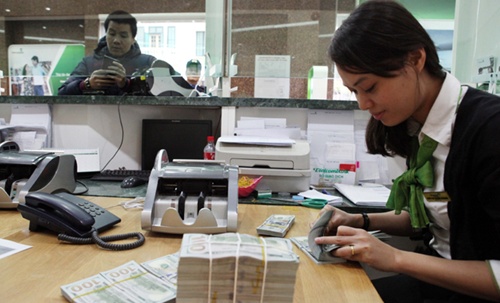Forex policy undermining speculation
 |
| A customer changes his currencies at Vietcombank in Ha Noi. Forex trading transactions were stable in local commmercial banks when the SBV applied its new policy. - Photo Tran Viet |
At the discussion on exchange rate on Monday, director of the State Bank of Viet Nam's Monetary Policy Department, Bui Quoc Dung said that the foreign exchange market has responded positively to the new policy.
From the beginning of this year, the central bank has applied a new exchange rate mechanism in which it sets a "central exchange rate" or a reference rate every day, instead of maintaining a fixed rate for a long period of time. The trading band of the new rate continues to be plus or minus three per cent.
Dung said for the past two weeks after the new policy had been applied, the US dollar/dong central rate has changed flexibly, staying at VND21,917 per dollar by January 15, up VND27 against the end of last year. However, the rate quoted at commercial banks in the period decreased roughly VND50 to VND60 per dollar against the end of 2015.
Dung attributed the central rate rise to the impact of the global market including the devaluation of the yuan, a decline in the Chinese securities market and a rise in US dollar value.
He said that the new policy has encouraged organisations and individuals to sell the greenback to commercial banks, adding that liquidation in the domestic forex market has been good, with smooth transactions for the past two weeks. He also expected that transactions of the greenback would further ease the next time.
According to Dung, the achievement was notable, especially when the global financial market had seen many consecutive negative changes.
It showed that besides reducing the speculation, the new policy has also helped the forex market to better adapt to external shocks, he said.
He said that the daily little change in the central rate would not cause shocks for the domestic forex market and enterprises, and would allow firms to pay more attention to preventing risks caused by the foreign exchange rate.
At the discussion, banking expert Le Xuan Nghia believed that from now on, foreign currency inflow to Viet Nam would be larger than the outflow, or foreign currency supply would exceed demand if the country could eliminate the dollar speculation.
Nghia also forecast that the devaluation of the dong against the dollar this year would be roughly 3 per cent.
Meanwhile, General Director of HSBC Viet Nam Pham Hong Hai said that the devaluation this year would be less than 4 per cent, but higher than the 1-2 per cent rate of the previous year, due to a rising volatility in the global market.
Under the new exchange rate policy, the dollar/dong rate would now be based on the exchange rate changes in the inter-bank foreign exchange market, as well as monetary developments in countries that are involved with Viet Nam's trade, investment and financing, to a major extent.
The daily-adjusted rate was to be in line with the macro-economic balance and would be the basis for local credit institutions and branches of foreign banks to provide their foreign exchange services, it said.
The central bank said that such a mechanism would enable it to ensure its management directives, while letting the exchange rate move flexibly as per global monetary fluctuations.
However, to be able to take appropriate measures under the new policy, besides having to map out new measures such as forward transactions, the central bank must also actively watch the forex market and the impact of domestic and international macro factors on the rate daily.
What the stars mean:
★ Poor ★ ★ Promising ★★★ Good ★★★★ Very good ★★★★★ Exceptional
Latest News
More News
- Securing capital and efficiency for Vietnam’s 2026-2030 growth ambitions (December 17, 2025 | 10:00)
- Energy sector in need of blended finance mechanisms (December 17, 2025 | 09:00)
- Vietnam still has room to mobilise capital for sustainable growth (December 17, 2025 | 08:57)
- Long-term capital seen as key hurdle to green growth (December 16, 2025 | 08:00)
- Gold prices swing amid tax debate and import uncertainty (December 15, 2025 | 18:04)
- Agribank frames bank credit as catalyst for green growth (December 15, 2025 | 17:59)
- Vietnam’s green transition demands collective financial action (December 15, 2025 | 12:00)
- VIR workshop highlights capital and policy for sustainable development (December 15, 2025 | 11:00)
- Promoting digital assets initiative in Vietnam (December 13, 2025 | 09:30)
- Experts flag gaps as national financial strategy under review (December 12, 2025 | 15:13)


















 Mobile Version
Mobile Version